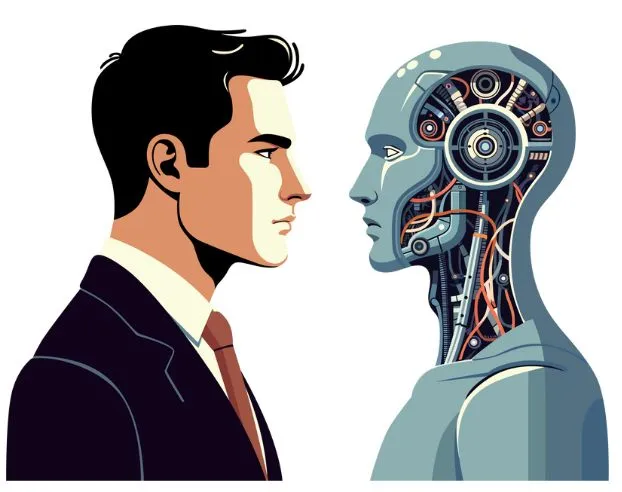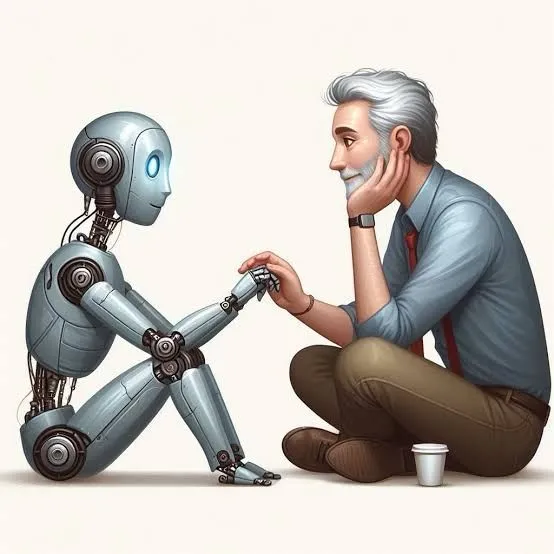In a world where AI can mimic empathy and hold conversations, research shows human connection remains the foundation of therapeutic efficacy. Discover why authentic emotional support requires the irreplaceable warmth of being truly seen by another person.
In an Age of Automation, Why the Human Heart Still Matters Most
We live in a world where artificial intelligence can write poetry, diagnose medical conditions, and even simulate empathetic conversations. AI chatbots can respond to your emotional distress within seconds, offering perfectly crafted words of comfort and support. Yet despite these technological marvels, something fundamental remains missing—the irreplaceable warmth of genuine human connection. Research from the National Centre for Psychological Studies confirms that it is the human connection in therapy that provides the basis for therapeutic efficacy, not just the delivery of correct responses or techniques. When we're hurting, we don't just want the right answer; we want someone who's really there, someone who chooses to stay with us in our pain.
What AI Can Do Well (And What It Cannot)
AI's Impressive Capabilities
Modern AI can analyze your words, detect emotional patterns, and respond with remarkable accuracy. It can be available 24/7, never gets tired, and can process vast amounts of mental health research to provide evidence-based responses. AI doesn't judge, doesn't have bad days, and can offer consistent support to thousands of people simultaneously. For basic information, crisis intervention resources, or structured therapeutic exercises, AI can be genuinely helpful and accessible.
The Fundamental Limits of Artificial Empathy
But AI doesn't feel anything. It cannot sit in comfortable silence with you when words fail. It doesn't recognize the subtle quiver in your voice that signals you're about to break, or understand the significance of the pause you didn't mean to take. AI can mimic empathy brilliantly, but it cannot experience the genuine concern that comes from one human caring about another. It processes your words as data points, not as the vulnerable sharing of a fellow human being.
The Missing Element: Shared Humanity
Real empathy isn't transactional—it's felt. It emerges from shared experience, from the knowledge that the person listening has also felt overwhelmed, heartbroken, or lost. When another human says 'I understand,' there's an implicit recognition that they, too, have navigated the complexity of being human. This shared vulnerability creates a connection that no algorithm can replicate, no matter how sophisticated its programming.
Why Being Truly Seen Requires Another Human
The healing power of human connection goes far beyond receiving helpful advice or coping strategies.
True empathetic listening involves being witnessed in your full humanity—your struggles, your contradictions, your growth, and your pain. When another person chooses to be present with your experience, they're offering something AI fundamentally cannot: the decision to care. That choice—to listen, to stay, to understand—transforms both the listener and the person being heard. It's not just about processing information; it's about human souls connecting across the fundamental loneliness of individual experience.
The Science Behind Human-to-Human Healing
Therapeutic Relationships Drive Outcomes
Decades of psychotherapy research consistently show that the quality of the therapeutic relationship—not specific techniques or interventions—is the strongest predictor of successful treatment outcomes. This relationship is built on trust, mutual respect, and genuine human connection. While AI can deliver therapeutic techniques, it cannot form the authentic relationship that makes those techniques effective. The healing happens in the space between two people, not in the delivery of information.
Mirror Neurons and Emotional Resonance
Neuroscience research reveals that humans have mirror neurons that fire both when we experience an emotion and when we observe someone else experiencing that same emotion. This biological capacity for emotional resonance allows us to literally feel with others in ways that create profound connection and understanding. AI can recognize emotional patterns, but it cannot experience the neurological resonance that forms the foundation of genuine empathy.
The Physiology of Being Heard
When people feel genuinely heard and understood by another human, measurable physiological changes occur: stress hormones decrease, heart rate stabilizes, and the nervous system calms. This isn't just psychological comfort—it's biological healing that happens through authentic human connection. The presence of a caring person who truly listens activates our parasympathetic nervous system, creating the safety needed for emotional processing and growth.
What Happens in the Irreplaceable Moments
The Power of Shared Silence
Sometimes the most healing moments happen in silence—when someone sits with you in your pain without trying to fix it, explain it, or make it better. AI cannot sit in silence meaningfully because silence, for AI, is simply absence. For humans, silence can be presence, comfort, solidarity, and understanding. The ability to be with someone in their difficult emotions without needing to change them is a uniquely human gift.
Intuitive Understanding
Humans can sense when something is being left unsaid, when the real issue lies beneath the surface, or when someone needs gentle encouragement to go deeper. This intuitive understanding comes from our own experiences of hiding pain, avoiding difficult truths, or struggling to find words for complex emotions. AI can analyze patterns, but it cannot intuitively know when to probe gently or when to simply witness.
The Courage to Be Vulnerable
Opening up about our deepest struggles requires enormous courage, and that courage is often inspired by the vulnerability we sense in another person. When someone shares their own struggles or shows genuine emotional response to our pain, it creates permission for deeper honesty. AI cannot model vulnerability because it has no personal experience of struggle, fear, or growth to share.
Building Trust in the Small, Human Moments
Trust develops through countless small interactions that demonstrate genuine care and presence. It's built when someone doesn't interrupt you mid-sentence, when they ask what you need instead of assuming they know, when they remember details from previous conversations that mattered to you. Trust grows when someone shows up consistently—not just programmatically, but with the choice to prioritize your wellbeing. These moments of connection happen between humans who are both imperfect, both learning, both choosing to care despite their own limitations.
The healing power of being truly heard emerges from this mutual humanity, not from the perfect delivery of optimal responses.
When AI Helps and When Humans Are Essential
AI's Valuable Supporting Role
AI can provide excellent support for information gathering, crisis resource identification, scheduling, psychoeducation, and practicing specific skills between therapy sessions. It can offer 24/7 availability for people in crisis who need immediate coping strategies or safety planning. AI can also help reduce barriers to mental health support by providing anonymous, stigma-free initial assistance that might encourage someone to seek human support later.
When Human Connection Is Irreplaceable
Complex trauma, deep grief, relationship conflicts, identity struggles, and major life transitions all require the nuanced understanding that comes from lived human experience. When someone needs to process shame, work through trust issues, or navigate the complexity of family dynamics, they need someone who understands these challenges from their own humanity, not from data analysis.
The Integration Approach
The future of mental health support likely lies not in choosing between AI and humans, but in thoughtful integration. AI can handle routine tasks, provide educational resources, and offer immediate support, freeing humans to focus on what they do best: forming meaningful relationships, providing nuanced understanding, and offering the irreplaceable gift of genuine care and presence.
In the Moments That Matter Most, We Need Each Other
Connection is inherently messy because humans are messy. Emotional safety takes time to build because trust develops through repeated experiences of being seen and accepted. Neither genuine empathy nor authentic healing can be outsourced to code, no matter how sophisticated. When we're at our most vulnerable—facing loss, navigating crisis, or struggling with our deepest fears—we don't look for tools or solutions. We look for another human being who will choose to see us, stay with us, and remind us through their presence that we're not alone. In a world increasingly mediated by technology, the simple act of one person truly listening to another becomes even more precious. It's not that AI has no place in mental health support—it's that some aspects of healing will always require the irreplaceable warmth of human connection.





